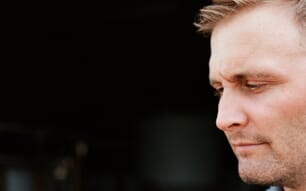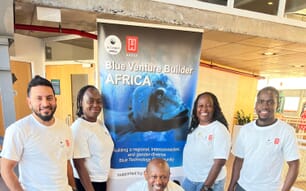Identity
Sparus aurata (Linnaeus, 1758)
FAO Names: En - Gilthead seabream, Fr - Dorade royale, Es - Dorada
Biological Features
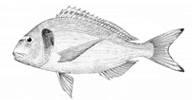
Body oval, rather deep and compressed. Head profile regularly curved. Eye small. Mouth low, very slightly oblique. Lips thick. Four to 6 canine-like teeth anteriorly in each jaw, followed posteriorly by blunter teeth which become progresively molar-like and are arranged in 2 to 4 rows (teeth in the 2 outer rows stronger). Total gill rakers on first arch short, 11 to 13, 7 or 8 lower and 5 (rarely 4) to 6 upper. Dorsal fin with 11 spines and 13 to 14 soft rays. Anal with 3 spines and 11 or 12 soft rays. Cheeks scaly, preopercle scaleless. Scales along lateral line 73 to 85. Colour silvery grey; a large black blotch at origien of lateral line extending on upper margin of opercle where it is edged below by a reddish area; a golden frontal band between eyes edged by two dark areas (not well defined in young individuals); dark longitudinal lines often present on sides of body; a dark band on dorsal fin; fork and tips of caudal fin edged with black.
Profile
Historical Background
Traditionally, gilthead seabream were cultured extensively in coastal lagoons and saltwater ponds, until intensive rearing systems were developed during the 1980s. The Italian 'vallicoltura' or the Egyptian 'hosha' are extensive fish rearing systems that act like natural fish traps, taking advantage of the natural trophic migration of juveniles from the sea into coastal lagoons. Gilthead seabream are very suitable species for extensive aquaculture in the Mediterranean, due to their good market price, high survival rate and feeding habits (which are relatively low in the food chain).
Artificial breeding was successfully achieved in Italy in 1981-82 and large-scale production of gilthead seabream juveniles was definitively achieved in 1988-1989 in Spain, Italy and Greece. The hatchery production and farming of this fish is one of the success stories of the aquaculture business. This species very quickly demonstrated a high adaptability to intensive rearing conditions, both in ponds and cages, and its annual production increased regularly until 2000, when it reached a peak of over 87 000 tonnes.
Main Producer Countries
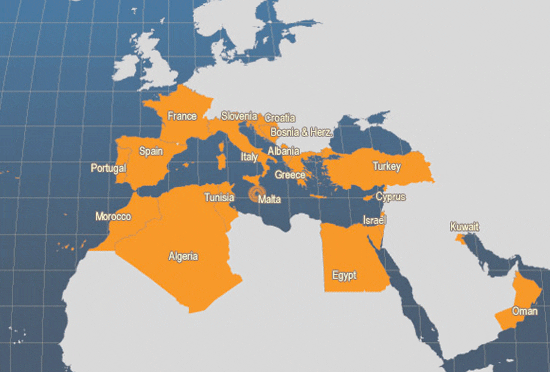
Habitat and biology
Sparus aurata is common in the Mediterranean Sea, present along the Eastern Atlantic coasts from Great Britain to Senegal, and rare in the Black Sea. Due to its euryhaline and eurythermal habits, the species is found in both marine and brackishwater environments such as coastal lagoons and estuarine areas, in particular during the initial stages of its life cycle. Born in the open sea during October-December, juveniles typically migrate in early spring towards protected coastal waters, where they can find abundant trophic resources and milder temperatures. Very sensitive to low temperatures (lower lethal limit is 4 °C), in late autumn they return to the open sea, where the adult fish breed. In the open sea gilthead seabream are usually found on rocky and seagrass (Posidonia oceanica) meadows, but it is also frequently caught on sandy grounds. Young fish remain in relatively shallow areas (up to 30 m), whereas adults can reach deeper waters, generally not more than 50 m. This species is a protandrous hermaphrodite. Sexual maturity develops in males at 2 years of age (20-30 cm) and in females at 2-3 years (33-40 cm). Females are batch spawners that can lay 20 000-80 000 eggs every day for a period up to 4 months. In captivity, sex reversal is conditioned by social and hormonal factors.
Production
Production Cycle
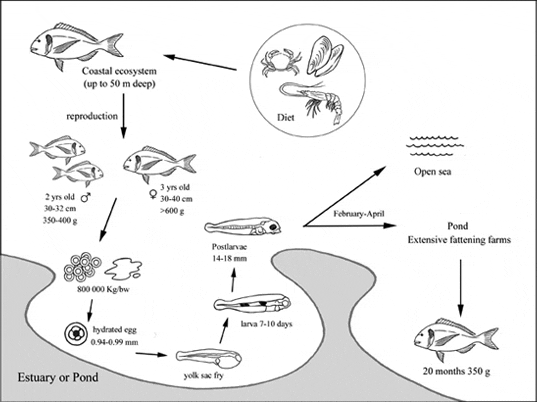
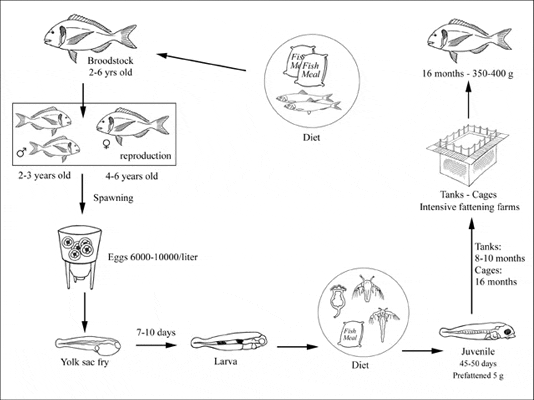
Production Systems
Seed Supply
Usually every hatchery has its own broodstock unit, where breeders of various age groups, from 1 year-old males to 5-year old females, are kept under long-term stocking conditions. Breeders can come either from a farm or from the wild.
At the beginning of the spawning season selected batches of breeders are transferred from their long-term location to the spawning tanks. The control of the sex ratio in spawning tanks is a very important factor for gilthead seabream and precautions need to be taken because sex reversal is socially determined. The presence of young males at the end of the spawning period, for instance, increases the number of older fish that become females. On the other hand, the occurrence of older females reduces sex reversal in younger fish.
Out-of-season spawning
Gilthead seabream broodstock may be conditioned by environmental manipulation in order to extend or modify reproduction time. Fish are stocked in tanks equipped with a water heating/cooling system and computerized control of temperature and light intensity. Sexual maturation is obtained by exposing the broodstock to photoperiod and water temperature conditions that occur during the natural spawning period. Female spawning can be obtained by GnRHa(1) (D-Ala6; Pro9Net-mGnRH ) inoculation (5-20 mg/kg).
There are two principal systems of gilthead seabream larval rearing called small-scale and large-scale. The small-scale (<10 m³) rearing system is characterized by maximum control of environmental parameters and is conceived in order to produce a large number of juveniles (150-250/litre). The large-scale (~200 m³) technique simulates a natural ecosystem. This technique guarantees much better larval quality than the small-scale system, but produces far less juveniles (maximum 10/litre).
Gilthead seabream larvae generally deplete their yolk sacs after 3-4 days of endogenous feeding. At this stage, the eyes are pigmented and the mouth developed, allowing the larvae to prey on larval organisms. In most rearing systems the first living organisms used for larval feeding are rotifers (e.g. Brachionus plicatilis); these are chosen due to the relative ease with which they can be culture on a large scale. After 10-11 days, rotifers are integrated with Artemia salina nauplii until the larvae accomplish metamorphosis (32-35 days post-hatching). Prior to being fed to the larvae, both rotifers and artemia are routinely enriched with commercial lipid preparations, to enhance their levels of certain essential fatty acids (EPA; DHA) and vitamins that are critically important for good growth, development and survival. In Mediterranean hatcheries microalgae (e.g. Chlorella sp., Isochrysis galbana, Pavlova lutheri, Nannochloropsis oculata, N. gaditana, Dunaliella tertiolecta) are used both for rotifer production and to improve the water quality in the larval tanks, creating the so-called 'green water' that is used during the initial rearing phases.
Weaning with a dry high-protein (50-60 percent) formulated diet takes place when fish reach a weight of 5-10 mg.
Nursery
Juveniles at about 45 days old are generally moved into a dedicated section of the hatchery equipped with larger round or rectangular tanks (10-25 m³), where weaning takes place. The weaning stage is a truly intensive rearing system. Initial fry density is generally 10-20/litre at a temperature of 18 °C and salinity of 35-37‰. Final density can reach 20 kg/m³ of 2-3 g fish. Feed is presented at 2-hour intervals from 08.00 to 20.00, using increasing percentages of artificial feeds composed of 150-300 µm particles. Dry feed should initially be presented at about 20 g/m³.
Ongrowing Techniques
Gilthead seabream can be farmed in various ways: in coastal ponds and lagoons, with extensive and semi-intensive methods; or in land-based installations and in sea cages, with intensive farming systems. These methods are very different, especially regarding fish farming density and food supply.
Extensive system
This system is based on the natural migration of euryhaline fish, when the fish may be caught, generally in typical fishing traps. Since this practice provides a very limited and unpredictable source of natural juveniles, many modern commercial extensive production units rely on both wild-caught and hatchery-reared juveniles. Generally, 2-3 g gilthead seabream are seeded into the lagoons in April-May.
Under these systems gilthead seabream reach the first commercial size (350 g) in 20 months and are usually farmed together with mullets, eels and European seabass. In North Mediterranean lagoons, wintering in deep basins, with freshwater/seawater stratification, is needed in order to preserve one year old gilthead seabreams.
The total production of this kind of polyculture ranges from 30-150 kg/ha/yr according to lagoon productivity. In north-eastern Italian lagoons the production of gilthead seabream represents 15-30 kg/ha/yr of the total. During the production cycle the fish feed on natural lagoon resources; no supplementary food is provided. In extensive fish farming the fish density generally does not exceed 0.0025 kg/m³.
Semi-intensive systems
In this system human control of the farming environment is greater than in the extensive system. It may simply involve seeding lagoons with juveniles pre-fattened in an intensive system, to minimize mortality and shorten farming time. In this case it is also possible to fertilize the farming area in order to increase natural food availability. Other types of semi-intensive farming involve more control, and comprise the provision of artificial feed and supplemental oxygen. This type of semi-intensive farming system is usually carried out in net enclosures within limited areas of the lagoons. The final production can vary widely, according to the size of the juveniles stocked and the amount of feed presented. The density in semi-intensive systems does not normally exceed 1 kg/m³ and production ranges between 500-2 400 kg/ha/yr.
Intensive systems
Intensive grow-out normally follows other intensive farming phases, namely reproduction, larval rearing and pre-fattening, as described above. Gilthead seabream intensive pre-fattening and grow-out phases may be carried out in land-based installations with rectangular concrete tanks that vary in size (200-3 000 m³) according to fish size and the demands of production. Grow-out may also occur in sea cages, either in sheltered or semi-exposed sites (floating cages) or totally exposed sites (semi-submersible or submersible cages).
Intensive systems may be stocked with juveniles purchased from separate hatcheries, but large production units normally rear their own. In intensive grow-out systems the FCR is usually very favourable (about 1.3:1).
When gilthead seabream are reared in tanks very high densities are used, ranging from 15-45 kg/m³ and massive oxygen injection is needed to ensure fish survival. Under excellent conditions (18-26 °C), pre-fattened small gilthead seabreams (5 g) reach first commercial size (350-400 g) in about one year.
Ongrowing in sea cages is simple and economical; it is the fattening system normally used in the Mediterranean basin. Although densities (10-15 kg/m³) are lower than in tanks, there are great advantages that make cages farming more profitable. For example, there are no energy costs for pumping, aeration, or post-rearing water treatment. However, it is not possible to control temperature in cage rearing, resulting in a longer rearing period to market size, or the necessity to stock larger juveniles. On average, larger pre-fattened gilthead seabream (10 g) reach first commercial size (350-400 g) in about one year, while smaller juveniles (5 g) reach the same size in about 16 months.
Feed Supply
Feeds are distributed by automatic feeders at 2-hour intervals from 08.00 to 20.00 for small fish (1-3 g), using increasing percentages of artificial feeds composed of 150-300 µm particles, or by hand for larger fish. Grading is necessary at least two or three times per cycle, in order to avoid growth differentiation. Fattening can occur in tanks or in cages system.
Harvesting Techniques
Before harvesting some days of starvation are needed. The length of this period varies, according to temperature and feeding rate (for example, at 25 °C, 24 hours may be enough). At lower temperatures, 48-72 hours are necessary. After correct starvation, the fish are ready to be harvested. Before starting this operation, the presence of dying or dead fish needs to be checked.
It is possible to harvest the fish in all weather conditions in land-based installations. In concrete tanks, workers push the animals toward the water inlet using a small trawl; then they remove them with dipnets or by pumping. Great attention is paid to cleaning the bottom of the tank before harvesting; this assures more hygienic fish and ensures that they have good organoleptic characteristics, as it avoids undesirable materials entering the gills and mouth.
Sea cages can be harvested when weather conditions are acceptable for the safety of the workers. Fish must be crowded into a relatively small area so that the animals can be harvested with dipnets or vacuum pumps.
Handling and Processing
In both sea cages and in land-based installations, gilthead seabream are normally killed by thermal shock; fish are put into tubs (plastic or stainless steel tubs) with iced water, which should be saturated with CO2, in order to reduce their suffering. Care is needed when taking the fish out of the water to pack them. This should be done rapidly to prevent scale loss and to preserve the appearance and brightness of the skin.
Production Costs
Production costs for 2 g juveniles in Italy vary from EUR 0.10-0.18/fish, depending on the fattening system. Costs for 5 g fry are about EUR 0.26-0.28/fish. The rearing costs to produce 350 g gilthead seabream range between EUR 3.0-4.0, depending on the rearing system.
Diseases and Control Measures
The major disease problems affecting gilthead seabream are included in the table below.
In some cases antibiotics and other pharmaceuticals have been used in treatment but their inclusion in this table does not imply an FAO recommendation.
| Disease | Agent | Type | Syndrome | Measures |
|---|---|---|---|---|
| Pasteurellosis (Pseudotuberculosis) | Photobacterium damselae subsp. piscicida | Bacterium | Anorexia; focal necrosis of the gills | Vaccination of broodstock and juveniles; use of immunostimulant and vitamin treatments; good hygiene and disinfection of water supply; antibiotics |
| Vibriosis | Photobacterium damselae subsp. damselae | Bacterium | Dark skin; lethargy; distended abdomen; haemorrhages | Avoid use of feed with very high lipid levels; antibiotics |
| Vibrio alginolyticus | Bacterium | Haemorrhages; dark skin; skin lesions | Good hygiene; antibiotics | |
| Vibrio anguillarum | Bacterium | Lethargy; anorexia; head down position | Good hygiene and disinfection of water supply; antibiotics | |
| Lymphocystis | Iridoviridae | Virus | Whitish pseudotumour | Reduce feeding rate; reduce biomass; avoid additional stress on diseased fish; low pathogenicity - no treatment |
| Aquareovirus | Aquareovirus | Virus | None | Low pathogenicity - no treatment |
| Distended Gut Syndrome (DGS) | Virus-like particle | Virus | Distended abdomen; disoriented spinning motion; immobility with the head down | Effective UV treatment of incoming water during first larval stages |
| Parasitic Enteritis | Myxidium leei | Endoparasite | Lethargy; distended abdomen; hyperpigmentation | Avoid stressing fish; no treatment |
| Winter Disease Syndrome | Pseudomonas anguilliseptica (multifactorial) | Bacterium | 'Belly up' syndrome, with or without the presence of haemorrhaging | Effective disinfection and dry-out period for land-based fattened units; adapt feeding regime prepare fish for winter period; antibiotic treatment ineffective in vivo |
In general, to prevent disease it is necessary for Japanese amberjack farmers to maintain a healthy environment and, based on their experience, predict when and what kind of disease might be anticipated under existing conditions. If conditions indicate the potential for a disease epizootic, stocking density can be reduced and feeding can be curtailed. The removal of dead fish is the first step in the prevention of further spread of disease. Both sick and dead fish should be removed from the affected pens. Farms become more vigilant when water temperature rises above 28 ºC as Japanese amberjacks are more vulnerable to infectious diseases under such conditions.
Suppliers of pathology expertise
Each producing country has a government authority responsible for upholding statutory requirements, such as licensing, discharge control, disease control, etc., for details of which the relevant government aquaculture, fisheries and animal health departments should be contacted. Diagnostic services may be available from government departments, or private organizations or individuals.
Statistics
Production Statistics
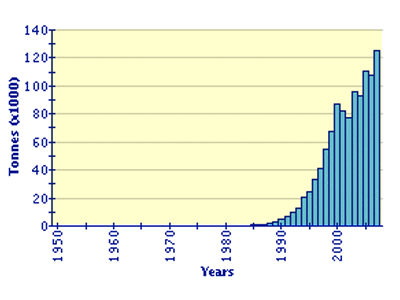
(FAO Fishery Statistic)
Most production occurs in the Mediterranean, with Greece (49 percent) being by far the largest producer in 2002. Turkey (15 percent), Spain (14 percent) and Italy (6 percent) are also major Mediterranean producers. In addition, considerable production occurs in Croatia, Cyprus, Egypt, France, Malta, Morocco, Portugal and Tunisia. There is also gilthead seabream production in the Red Sea, the Persian Gulf, and the Arabian Sea. The main producer is Israel (3 percent of total production in 2002); Kuwait and Oman are minor producers.
Market and Trade
As is the case with European seabass, the farming of gilthead seabream in the Mediterranean region is undergoing a transformation from being an industry of high margins and low volumes to one of low margins and high volumes. The rapid development of production in sea cages has led to declining prices; the ex-farm prices of both species decreased by approximately 60 percent between 1990 and 2000 and are still decreasing.
Although gilthead seabream ex-farm prices began to decrease between 1990 and 1995, they were still sufficient to interest investors and guaranteed a reasonable profit for farmers until 1998. However, in the last three years (2000-2003), the price of farmed gilthead seabream has collapsed; now the European market price is fluctuating around EUR 5.50/kg, for the 350 g size. At this level it is very difficult for farmers to make a fair profit.
Thus, at the moment, market conditions seem very far from those that pertained in the first half of the 1990s, but there are a few marketing strategies for rearing gilthead seabream profitably. One of these is the economies of scale (farming a lot of fish to reduce unit production costs). Alternatively, small production systems can increase the value of the product by producing low quantities of higher quality fish (e.g. organic fish) or by producing unconventional fish sizes, which can also be processed (e.g. filleted).
Status and Trends
TThe conventional market for seabream has become saturated. For future growth, the Mediterranean aquaculture industry needs to emphasize the adoption of more sophisticated methods of marketing. This is a must for penetrating new markets, but it is also necessary for enlarging the existing ones. As well as improved marketing organization, product diversification could help the seabream aquaculture in the Mediterranean region. Seabream should not only be available as a commodity item but also as a value-added product. The development of alternative markets and value-added products is likely to lead to higher requirements for controlled and predictable quality, and for larger fish.
The export activity of the Greece aquaculture industry, which is the main producer of seabream, has an almost exclusive orientation towards the Italian market. Since 1994, a few exporters have tried hard to penetrate new markets. The outcome of those efforts has resulted in exports to new markets in the UK, Germany, and France (20-22 percent new markets in 1996, compared to 1994).
Main Issues
The seabream industry could be described as a sector already entering its mature phase, but which still needs more efficient production systems and new technologies. These latter should take into account the need to minimize the potential impact of seabream aquaculture practices in coastal areas, such as:
- Farm location and the impact of discharges of organic matters, phosphorus and nitrogen, which can cause eutrophication.
- Farmed fish escapes that can lead to a number of problems, including dilution of the wild stock genetic pool through interbreeding, reduced wild stock fecundity, and changes in the structure of the food web.
- Transfer of diseases parasites between farmed and wild fish.
- Introduction of non-indigenous species that can act as 'pests' in local communities.
Responsible Aquaculture Practices
The main objective of the Committee on Aquaculture of the General Fisheries Commission for the Mediterranean (CAQ-GFCM) is to implement the Code of Conduct for Responsible Fisheries (CCRF) principles in the Mediterranean Region. Furthermore, providing regulations and incentives for improving sustainable aquaculture practices, through appropriate planning, has been recognized by the Federation of European Aquaculture Producers (FEAP).
October 2010



